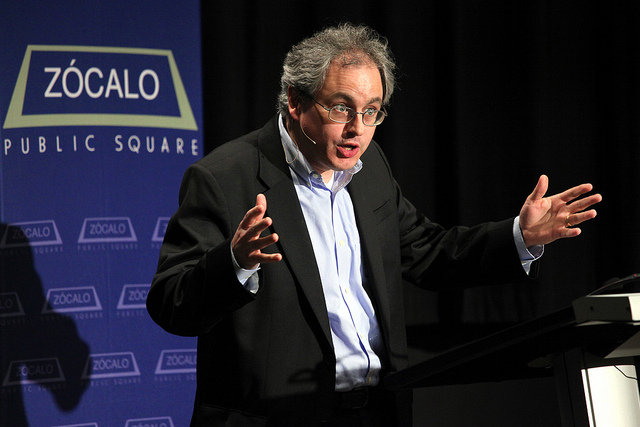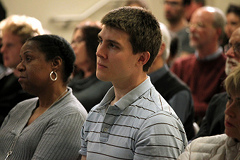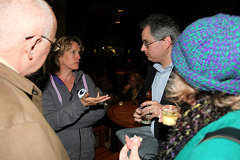
Economist Charles Kenny began his lecture at the Goethe-Institut by explaining the major problem with his own new book.
“It’s about exciting stuff that doesn’t happen. The book is about how much more frequently around the world nothing much is going on. Nobody starves, nobody gets sick, nobody gets shot, and nobody dies.”
But that’s exactly the point, said Kenny, a senior economist at the World Bank and senior fellow at the Center for Global Development whose book is called Getting Better: Why Global Development is Succeeding – And How We Can Improve the World Even More. There is less “bad stuff” happening in the world, signaling that things are better around the globe.
Kenny said people often assume the world is getting worse because so much attention is paid to its problems. Yet, he insists, by many objective measures – health, education and happiness, to name a few – life has never been so good.
First, the Bad News
 Where people are correct in saying the world is worsening, Kenny said, is in the realm of income. Millions, if not billions, of people around the world are no better off financially than their parents, grandparents, or distant ancestors, he said.
Where people are correct in saying the world is worsening, Kenny said, is in the realm of income. Millions, if not billions, of people around the world are no better off financially than their parents, grandparents, or distant ancestors, he said.
“In 1950, the gap between the richest and poorest countries was about 33-fold,” he said. “Today, it is not 33-fold, it is more like 137-fold. And 800 million or so people still live on a dollar a day or less, and you just can’t get poorer than that.”
The reasons are attributable many years of history, he said, using two contrasting stories to illustrate. First he told the tale of Mungo Park, a Scottish doctor, who set out to find Tumbuktoo in 1805. Park’s team survived torrential rains, packs of lions and more, but ran into several tropical diseases, including dysentery and malaria. By the end, 41 of 43 people on the expedition had died – and when Park’s son set out to find him, he contracted malaria and died too.
Meanwhile, Lewis and Clark’s trip across America was occurring. They were gone for longer and exposed to just as many potentially devastating natural elements, but just one of 33 died. The results of those two trips show how much easier life can be on the developed continents.
“Africa remains to this day home to a lot of diseases we don’t know how to deal with,” Kenny said.
The Death Factor
 The most important way to measure whether life is improving, though, is how long the average life lasts, Kenny said. And by that standard, the world has gotten better by leaps and bounds. The life expectancy for someone born in Africa averaged 41 in 1960, compared to 51 in 2005, he said.
The most important way to measure whether life is improving, though, is how long the average life lasts, Kenny said. And by that standard, the world has gotten better by leaps and bounds. The life expectancy for someone born in Africa averaged 41 in 1960, compared to 51 in 2005, he said.
Even in the 12 countries in which average incomes declined between 1960 and 2005 – Haiti, the Central African Republic, the Ivory Coast, Liberia, Madagascar, Nicaragua, Niger, Senegal, Sierra Leona, Venezuela, Zambia and Zimbabwe – life expectancy increased by more than 10 years.
“The declining cost of living means that people as poor as they have ever been – as poor as their parents, grandparents and ancestors back to the Roman Empire – are living longer and healthier,” he said.
Meanwhile, the rate of infant mortality has declined 75 percent over the past century, Kenny said. And the number of people who die on the battlefield is at a 60-year low.
Alluding back to his first point about how worldwide improvements mean less excitement, Kenny explained how seemingly boring lives look when they are going well.
“If you look at anything else apart from money, we’ve seen rapid, ubiquitous, worldwide progress toward beautiful banality,” he said.
That trend is demonstrated by movement in education and politics, Kenny said. More children are in school, more people vote, more people can read and hold jobs – the facets of life that most Americans take for granted.
Simple Technology
 Many deadly diseases have been cured not by expensive technology that is inaccessible to poor people, but by simple fixes that can be carried out anywhere, he said. A cholera outbreak in Bangladesh in 1971 was contained through a brilliantly simple solution devised by a doctor named Dilip Mahalanabis.
Many deadly diseases have been cured not by expensive technology that is inaccessible to poor people, but by simple fixes that can be carried out anywhere, he said. A cholera outbreak in Bangladesh in 1971 was contained through a brilliantly simple solution devised by a doctor named Dilip Mahalanabis.
Mahalanabis was running out of saline solution to rehydrate people suffering from diarrhea caused by cholera, so he made a move frowned upon by public health experts at the time: he mixed sugar, salt and water and told people to force it down sick relatives’ throats until they couldn’t stand it anymore.
“It is a brilliant way to deal with water-borne diseases that costs cents and can be done by untrained individuals,” he said. “The death rate went down from 20 or 30 percent of those who had the disease to two or three percent.”
A similar process eradicated smallpox worldwide, Kenny said. The disease was responsible for as many as half a million deaths in the 20th century, he said, but had disappeared by the 1970s.
“The total cost of the global program was in the region of $312 million – perhaps 32 cents per person in infected countries,” he said.
Spreading Knowledge
The key to replicating such success on still-existent diseases, he said, is disseminating information. Too many families in developing countries don’t know that oral rehydration is the cure for diarrhea, for example.
“We don’t need to wait on Tanzania or Ethiopia becoming as rich as Luxembourg to roll [vaccines] out,” Kenny said. “Even the poorest countries can afford universal primary education.”
So, he said, the notion that some countries cannot be saved or some diseases cannot be cured is a fallacy.
“We know things can get better because things have been getting better – ubiquitously, rapidly, and with a large part played by development assistance,” he said. “So sure, cut funding for development if you want to … but don’t hide behind the excuse that aid can’t work. It has and it can.”
For event photos, please click here.
For full video, please click here.
For an excerpt from Getting Better, please click here.
Buy the book: Skylight Books, Powell’s, Amazon
*Photos by Aaron Salcido




Send A Letter To the Editors